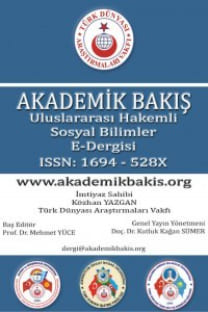TÜRK BANKACILIK SEKTÖRÜNÜN ETKİNLİK ANALİZİ: PARAMETRİK OLMAYAN KISMİ SINIR YAKLAŞIMI BAĞLAMINDA
Çalışmada,
parametrik olmayan Parçalı Sınır yöntemi kullanılmıştır. Bu yöntem parametrik
olmayan yöntemler içinde güçlü tutarlılık ve asimptotik normallik içermektedir.
Bu bağlamda, 1999 ile 2016 yılları arasını kapsayan 17 banka ile Türk
bankacılık sistemi incelenmiştir. Özetle, analiz sonuçları göstermektedir ki
1999 ile 2016 yılları arasında çıktı yönlü etkinlik görülmektedir. Bu durumu
m-order ve süper etkinlik değerleri firma bazında desteklemektedir. Çıktı ve
aşırı (hyper) etkinlik değerleri ele alınan dönem içinde birlikte
seyretmektedir. Bu durumda, girdi yönlü etkinlikten çok sektörün çıktı yönlü
etkinliğe odaklandığını desteklemektedir.
Anahtar Kelimeler:
Bankacılık; Teknik Etkinlik; Parçalı Sınır Yöntemi; Türk Bankacılık Sistemi; Üretim Fonksiyonu
THE EFFİCİENCY OF BANKİNG SECTOR İN TURKEY: NONPARAMETRİC CONDİTİONAL APPROACH BASED ON PARTİAL FRONTİER
Abstract
This
paper focuses on nonparametric efficiency analysis based on robust estimation
of Partial Frontiers. A nonparametric estimator is proposed achieving strong
consistency and asymptotic normality. In this context, the main aim of this
paper is how changed efficiency score of this sector in this period. So, the
paper analysed 17 different banks with 1999 to 2016 period in the Turkish
banking sector. Overall, it does show us that the Turkish banking sector
focused on output-oriented efficiency from 1999 to 2016.This result is
supported by m-order and super-efficiency firms scores. Then, output-oriented
and hyper-oriented are so close fluctuated together. This show that Turkish
banking sector was focused output efficiency more than input efficiency. The
efficiency score of the Turkish banking sector are moderate for the period
covered (0.6≥α≥0.4).
___
Aragon, Y., Daouia A. and Thomas-Agnan C. 2005. “Nonparametric Frontier Estimation: a Conditional Quantile-Based Approach. “Econometric Theory; 21; pp.358–389. Berger A, Mester LJ 2003. “Explaining the dramatic changes in performance of US banks: technological change, deregulation, and dynamic changes in competition”. Journal of Finance Intermed; 12(1); pp.57–95. Cazals C., Florens JP., Simar L. 2002. “Nonparametric Frontier Estimation: A Robust Approach.” Journal of Econometrics; 106; pp.1–25. Daouia, A. and Simar L. 2005. “Robust Nonparametric Estimators of Monotone Boundaries.” Journal of Multivariate Analysis, 96; pp.311-331. Daouia, A. and Simar L. 2007. “Nonparametric Efficiency Analysis: A Multivariate Conditional Quantile Approach.” Journal of Econometrics; 140; pp.375–400. Simar, L. and Vanhems A. 2012. “Probabilistic Characterization of Directional Distances and Their Robust Versions.” Journal of Econometrics; 166; pp.342–354. Simar, L., Vanhems A., Wilson P.W. 2012. “Statistical Inference for DEA Estimators of Directional Distances.” European Journal of Operational Research; 220; pp. 853–864. Simar L. and Wilson P.W. 2011. “Two-stage DEA: Caveat Emptor.” Journal of Productivity Analysis; 36; pp.205-215. Simar L. and Wilson P.W. 2015. “Statistical Approaches for Nonparametric Frontier Models: A Guided Tour” International Statistical Review; 83(1); pp.77–110. Sinha R.P. 2015. “Robust Benchmarking of Indian Mutual Funds-A partial Frontier Approach” International Journal of Financial Management; 5(2), 1-10. Wheelock D.C. and Wilson P. W. 2008. “Robust Non-Parametric Quantile Estimation of Efficiency and Productivity Change in U.S. Commercial Banking, 1985-2004.” Working Papers, Federal Reserve Bank of St. Louis.- Başlangıç: 2004
- Yayıncı: Akademik Bakış
Sayıdaki Diğer Makaleler
MÜKEMMELİYETÇİLİĞİN SONUÇLARI ÖLÇEĞİ'NİN TÜRKÇEYE UYARLANMASI
MÜKEMMELİYETÇİLİĞİN SONUÇLARI ÖLÇEĞİ'NİN TÜRKÇEYE UYARLANMASI
TEKNOLOJİ-GİTAR İLİŞKİSİ: MANYETİKLER ve EFEKTLER
ÇAĞRI MERKEZİ ÇALIŞANLARINDA DUYGUSAL ZEKÂNIN ÖRGÜTSEL ÖZDEŞLEŞME ÜZERİNDEKİ ETKİLERİ
BASINDA IRKÇILIK-TURANCILIK DAVASI
TÜRK BANKACILIK SEKTÖRÜNÜN ETKİNLİK ANALİZİ: PARAMETRİK OLMAYAN KISMİ SINIR YAKLAŞIMI BAĞLAMINDA
1980 ÖNCESİ VE 2000 SONRASI TÜRK SİNEMASINDA AİLENİN TEMSİLİ
